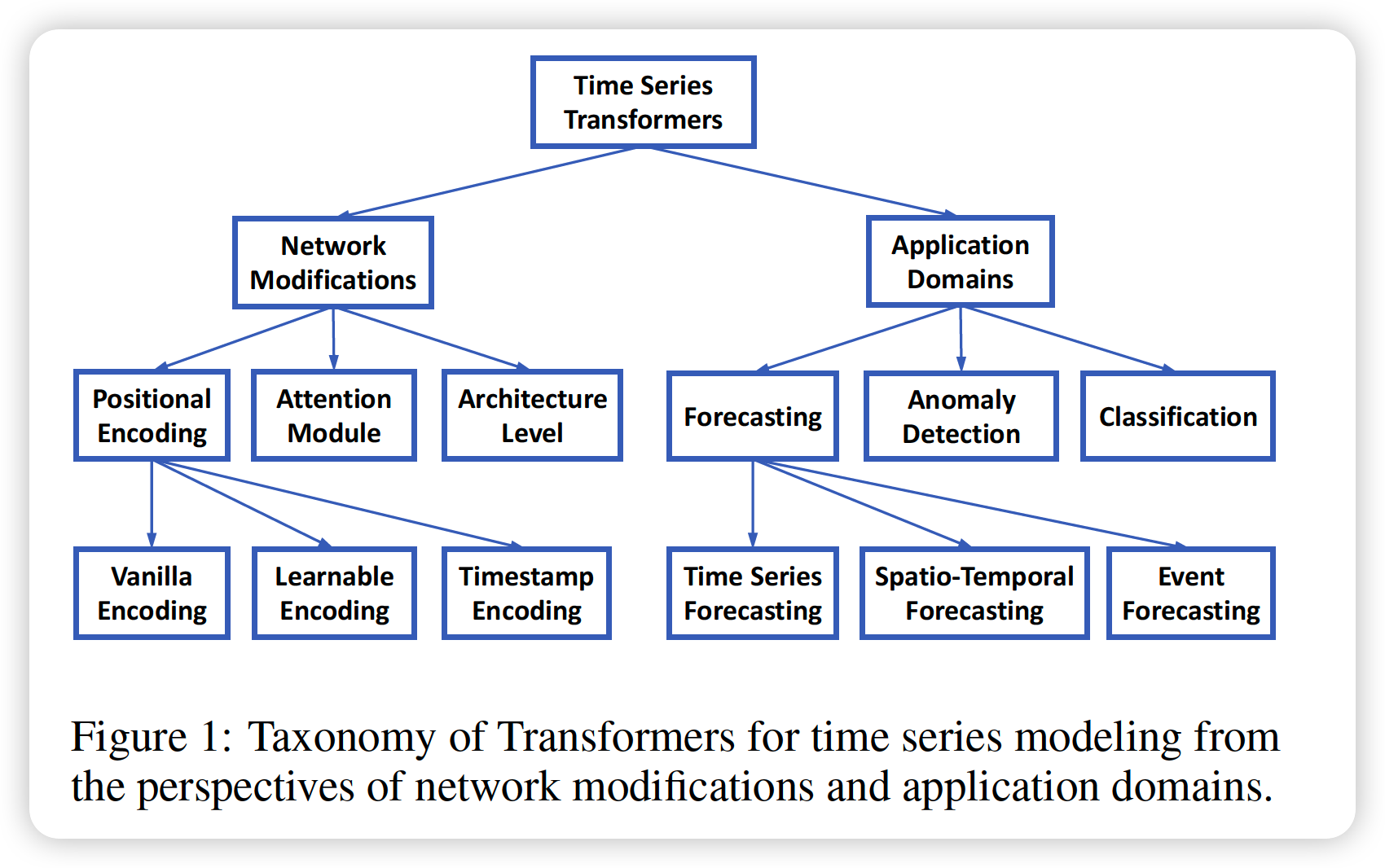Transformers in Time Series : A Survey (2022)
Contents
-
Introduction
- Preliminaries of the Transformer
- Vanilla Transformer
- Input Encoding & Positional Encoding
- Multi-head Attention
- FFNN & Residual Network
- Network Modifications for TS
- Positional Encoding
- Attention Module
- Applications of TS Transformers
- TS in Forecasting
- TS in Anomaly Detection
1. Introduction
Transformers :
- great modeling ability for LONG range dependencies / interatcions in SEQUENTIAL data
Summarize the development of time series Transformers
2. Preliminaries of the Transformer
(1) Vanilla Transformer
- skip
(2) Input Encoding & Positional Encoding
Transformer : no recurrence / no convolution
ABSOLUTE positional encoding
\(P E(t)_{i}= \begin{cases}\sin \left(\omega_{i} t\right) & i \% 2=1 \\ \cos \left(\omega_{i} t\right) & i \% 2=0\end{cases}\).
- \(\omega_{i}\) : hand-crafted frequency for each dimension
( or, can “LEARN” PE )
RELATIVE positional encoding
- pairwise positional relationships between input elements
HYBRID positional encoding
(3) Multi-head Attention
\(\operatorname{Attention}(\mathbf{Q}, \mathbf{K}, \mathbf{V})=\operatorname{softmax}\left(\frac{\mathbf{Q K}^{\mathbf{T}}}{\sqrt{D_{k}}}\right) \mathbf{V}\).
- \(\mathbf{Q} \in \mathcal{R}^{N \times D_{k}}\).
- \(\mathbf{K} \in \mathcal{R}^{M \times D_{k}}\).
- \(\mathbf{V} \in \mathcal{R}^{M \times D_{v}}\).
- \(N, M\) denote the lengths of queries and keys (or values)
uses multi-head attention with \(H\) different sets
-
\(\operatorname{MultiHeadAttn}(\mathbf{Q}, \mathbf{K}, \mathbf{V})=\) Concat \(\left(\right.\) head \(_{1}, \cdots\), head \(\left._{H}\right) \mathbf{W}^{O}\)
- \(h e a d_{i}=\) Attention \(\left(\mathbf{Q} \mathbf{W}_{i}^{Q}, \mathbf{K} \mathbf{W}_{i}^{K}, \mathbf{V} \mathbf{W}_{i}^{V}\right)\)
-
\(\operatorname{MultiHeadAttn}(\mathbf{Q}, \mathbf{K}, \mathbf{V})=\) Concat \(\left(\right.\) head \(_{1}, \cdots\), head \(\left._{H}\right) \mathbf{W}^{O}\) where \(h e a d_{i}=\) Attention \(\left(\mathbf{Q} \mathbf{W}_{i}^{Q}, \mathbf{K} \mathbf{W}_{i}^{K}, \mathbf{V} \mathbf{W}_{i}^{V}\right)\) 2.4 Feed-forward and Residual Network The point-wise feed-forward network is a fully connected module as
\(F F N\left(\mathbf{H}^{\prime}\right)=\operatorname{Re} L U\left(\mathbf{H}^{\prime} \mathbf{W}^{1}+\mathbf{b}^{1}\right) \mathbf{W}^{2}+\mathbf{b}^{2},\) where \(\mathbf{H}^{\prime}\) is outputs of previous layer, \(\mathbf{W}^{1} \in \mathcal{R}^{D_{m} \times D_{f}}\), \(\mathbf{W}^{2} \in \mathcal{R}^{D_{f} \times D_{m}}, \mathbf{b}^{1} \in \mathcal{R}^{D_{f}}, \mathbf{b}^{2} \in \mathcal{R}^{D_{m}}\) are trainable parameters. In a deeper module, a residual connection module followed by Layer Normalization Module is inserted around each module. That is, \(\begin{aligned} \mathbf{H}^{\prime} &=\operatorname{Layer} N \operatorname{orm}(\operatorname{Self} \operatorname{Attn}(\mathbf{X})+\mathbf{X}), \\ \mathbf{H} &=\text { Layer } N \operatorname{orm}\left(F F N\left(\mathbf{H}^{\prime}\right)+\mathbf{H}^{\prime}\right) \end{aligned}\) where SelfAttn(.) denotes self attention module and LayerNorm(.) denotes the layer normal operation.
(4) FFNN & Residual Network
\(F F N\left(\mathbf{H}^{\prime}\right)=\operatorname{Re} L U\left(\mathbf{H}^{\prime} \mathbf{W}^{1}+\mathbf{b}^{1}\right) \mathbf{W}^{2}+\mathbf{b}^{2}\)/
- \(\mathbf{H}^{\prime}\) : output of previous layer
Residual Network
- residual connection module followed by Layer Normalization Module
- \(\mathbf{H}^{\prime}=\operatorname{Layer} N \operatorname{orm}(\operatorname{Self} \operatorname{Attn}(\mathbf{X})+\mathbf{X})\).
- \(\mathbf{H} =\text { Layer } N \operatorname{orm}\left(F F N\left(\mathbf{H}^{\prime}\right)+\mathbf{H}^{\prime}\right)\).
3 .Network Modifications for TS

(1) Positional Encoding
( not much different
a) Vanilla PE
b) Learnable PE
- more flexible & adapt itself to specific task
c) Timestamp Encoding
- calendar timestamps
- Informer (2021)
- encode timestamps as additional positional encoding
(2) Attention Module
Self attention : \(O(L^2)\)
-
\(L\) : input TS length
-
computational bottleneck ( when long TS )
Reducing quadratic complexity!
- ex) LogTrans, Performer,…

(3) Architecture level Innovation
Informer
- insert max-pooling layers with stride=2
Pyraformer
- C-ary tree based attention mechanism
Both INTRA & INTER scale attentions capture temporal dependencies across different resolutions
4. Applications of TS Transformers
[ TS in Forecasting ]
Time Series Forecasting
LogTrans
- convolution self-attention ( use causal convolutions )
- Introduce sparse bias
- \(O(L^2) \rightarrow O(L \log L)\).
Informorer
- instead of introducing sparse bias,
- selects \(O(\log L)\) dominant queries, based on (queries & key) similarities
AST
- GAN framework
- train sparse transformer for TS forecasting
Autoformer
- simple ST decomposition
- auto-correlation mechansim working as an attention module
FEDformer
-
applies attention operation in the frequency domain
( with Fourier transform & Wavelet transform )
TFT
- multi-horizon forecasting model, with
- static covariate encoder
- gating feature selection
- temporal self-attention decoder
SSDNet & ProTran
- combine “Transformer” + “SSM (State Space Model)”
- SSDNet
- use Transformer to learn the temporal pattern
- estimate the parameters of SSM
- then applies SSM to perform the ST decomposition & interpretability
- ProTran
- generative modeling & inference, using VI
Pyraformer
- hierarchical pyramidal attention module
- with binary tree following path
Aliformer
- sequential forecasting for TS
- use Knowledge-guided attention
###
Traffic Transformer
- use self-attention…
- to capture temporal-temporal dependencies
- use GNN…
- to capture spatial dependencies
Spatial-temporal Transformer
-
spatial transformer block + GCN,
to better capture spatial-spatial dependencies
Spatio-temporal graph Transformer
- attention-based GCN
- able to learn a complicated temporal-spatial attentions
[ TS in Anomaly Detection ]
Reconstruction model plays a key role in AD tasks
Transformer based AD : much more efficient than LSTM based
TranAD
- proposes an adversarial training procedure, to amplify reconstruction errors
- GAN style adversarial training procedure :
- 2 Transformer encoders
- 2 Transformer decoders
TransAnomaly
-
VAE + Transformer
-
ror more parallelization
( reduce training cost by 80% )
MT-RVAE
- multiscale Transformer
- integrate TS information at different scales
GTA
- combine Transformer & Graph based learning architecture
